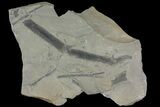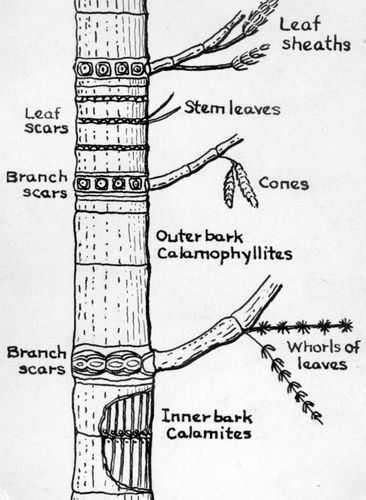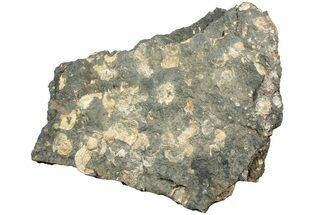This Specimen has been sold.
9.9" Fossil Horsetail (Annularia/Calamites) Plate - Kentucky
This is a gorgeous fossil flora plate that contains a well preserved Annularia/Calamites fossil. This plate was collected from the Breathitt Formation of Leslie County, Kentucky. It comes from the Late Carboniferous, Pennsylvanian aged forests that formed the coal shales of Kentucky and Ohio.
Annularia is the genus and refers to the leaves or whorl of the jointed-stemmed plant, Calamites, a close relative of modern horsetails.
Annularia is the genus and refers to the leaves or whorl of the jointed-stemmed plant, Calamites, a close relative of modern horsetails.
Calamites is the name (form genus) given to compression, impression, and pith casts of Carboniferous sphenophytes, which were arborescent (tree-like) relatives of modern horestails. Calamites typically grew as medium-sized understory trees in Carboniferous swamps, reaching heights of 20-30 meters (60-100 feet).
Similar to today's horsetails, Calamites species were hollow: however, their trunks contained lignin, and likely resembled bamboo in texture. Calamites may be found as cylindrical casts or elongate compressions and impressions. In either form, Calamites often has regular, evenly-spaced grooves or lines running the length of the specimen, or wide, irregularly-spaced nodes.
In some cylindrical casts, small circular bumps appear along the horizontal nodes. These indicate casts of the pith—the central portion of Calamites inside the wood of the stem. Casts of the bark's inner surface outside of the stem wood do not contain bumps.
Calamites leaves also have their own form genera. They formed in clusters of 8 or more, called whorls, at spaced nodes along stems. Annularia indicate flat, starburst-shaped whorls, but the shapes of the leaves themselves could vary from oval (A. sphenophylloides) to lanceolate or needle-like (A. radiata). Asterophyllites is another form genus of leaf clusters, but unlike Annularia, they curved upward into a sort of cup shape. Both had midline veins, making them easy to distinguish from other sphenophyte leaf clusters.
A third form genus, Sphenophyllum, is given to leaf clusters that are distinctly triangular, with branching veins radiating from their central nodes. Species with Sphenophyllum forms likely grew as shrubs or smaller plants, unlike Calamites forms.
We use these terms to describe the shapes of fossil imprints. Exact species are often difficult to determine, but these form taxa help in distinguishing the prolific species of sphenophytes that defined the Carboniferous Period.
Similar to today's horsetails, Calamites species were hollow: however, their trunks contained lignin, and likely resembled bamboo in texture. Calamites may be found as cylindrical casts or elongate compressions and impressions. In either form, Calamites often has regular, evenly-spaced grooves or lines running the length of the specimen, or wide, irregularly-spaced nodes.
In some cylindrical casts, small circular bumps appear along the horizontal nodes. These indicate casts of the pith—the central portion of Calamites inside the wood of the stem. Casts of the bark's inner surface outside of the stem wood do not contain bumps.
Calamites leaves also have their own form genera. They formed in clusters of 8 or more, called whorls, at spaced nodes along stems. Annularia indicate flat, starburst-shaped whorls, but the shapes of the leaves themselves could vary from oval (A. sphenophylloides) to lanceolate or needle-like (A. radiata). Asterophyllites is another form genus of leaf clusters, but unlike Annularia, they curved upward into a sort of cup shape. Both had midline veins, making them easy to distinguish from other sphenophyte leaf clusters.
A third form genus, Sphenophyllum, is given to leaf clusters that are distinctly triangular, with branching veins radiating from their central nodes. Species with Sphenophyllum forms likely grew as shrubs or smaller plants, unlike Calamites forms.
We use these terms to describe the shapes of fossil imprints. Exact species are often difficult to determine, but these form taxa help in distinguishing the prolific species of sphenophytes that defined the Carboniferous Period.
SPECIES
Annularia/Calamites sp.
LOCATION
Leslie County, Kentucky
FORMATION
Breathitt Formation
SIZE
9.9 x 7" rock
CATEGORY
ITEM
#176786
We guarantee the authenticity of all of our specimens.
 Reviews
Reviews












